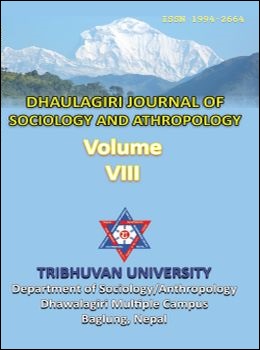Livelihood Change and Household Strategies: Social Divergence of the Working Class in Dhading
DOI:
https://doi.org/10.3126/dsaj.v8i0.10721Keywords:
Agricultural self-employment, household strategy, Mahesh Khola, nonfarm wage, relations of productionAbstract
How do households, in an agrarian setting under transition, reposition themselves amidst the increasing opportunities and constraints posed by expansive capitalist market? Do household responses exhibit any pattern that helps us understand long term social change? If so, what theoretical significance does such a pattern instigate in the wider political economic context of shifting class formations? This article mainly discusses recent dynamics in the organisation of production in Mahesh Khola, the research site in the South-East Dhading, from the perspective of intra-class divergence and social differentiation. It argues that the working class in Mahesh Khola is undergoing a process of internal differentiation that is reflected in two main, rather opposite, trends: on the one hand, part of the rural workforce is migrating to the capital city of Kathmandu in search of urban jobs, while on the other hand, and in contrary, an important segment of the same has intensified its engagement in agriculture. As a matter of fact, one can notice a weakening up of the working class in the rural setting.
DOI: http://dx.doi.org/10.3126/dsaj.v8i0.10721
Dhaulagiri Journal of Sociology and Anthropology Vol. 8, 2014; 29-54




